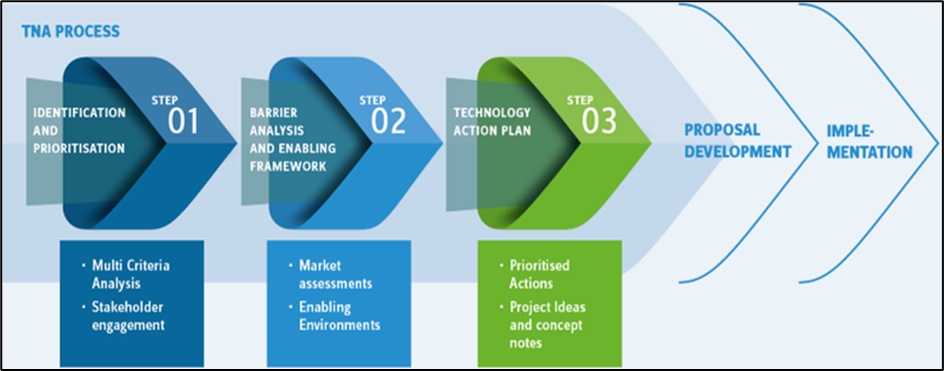Technology Needs Assessments
Pathways for climate technology implementation
Overview
What are Technology Needs Assessments (TNAs)?
Technology needs assessments (TNAs) are long-standing and evolving processes under the UNFCCC, which follow a comprehensive, country-driven, participatory and action-oriented approach, and result in the identification and prioritization of technologies needed for climate change adaptation and mitigation in different sectors of developing countries. TNAs also identify barriers to the development, transfer and uptake of these technologies and ways to address technology needs and barriers, including through technology action plans (TAPs). Countries are increasingly using their TNA and TAPs to inform the development and implementation of their Nationally Determined Contributions (NDCs) and long-term low greenhouse gas emission development strategies (LT-LEDS) under the Paris Agreement.
Check out these Success Stories and watch the video below to see how countries are benefiting from TNAs:
-
98
Number of developing countries with completed TNA
-
26
Number of developing countries that refer to TNAs in their NDCs
-
17
Number of developing countries currently undertaking a TNA
-
1839
Million USD in value of approved projects informed by TNAs
TNA Step-by-Step Process

Photo credit: UNEP Copenhagen Climate Centre
Step 1: Identifying and Prioritizing Technologies
This first step involves a comprehensive assessment of available technologies, technology needs and opportunities across different sectors. Key stakeholders are involved in the process to identify technologies with the highest potential to mitigate climate change and adapt to its impacts. Prioritization takes into account not only environmental benefits but also economic viability, social acceptability, and alignment with national development goals.
Step 2: Analyzing Barriers and Building an Enabling Environment
Once technologies have been prioritized, the TNA process identifies the challenges to their implementation. This includes identifying barriers such as inadequate funding, lack of capacity, policy gaps, and market failures. Solutions are then formulated to address these barriers, creating an enabling environment for technology adoption.
Step 3: Developing Technology Action Plans
The final step is to translate the prioritized technologies into concrete nationally-endorsed TAPs, which outline the specific actions required for technology implementation, including: roles and responsibilities (government, private sector, etc.); resources required (financial, human, etc.); timeframes; funding opportunities and mechanisms; and monitoring and evaluation procedures. TAPs are developed for sectors of an economy or for several or individual technologies.
More information and supporting materials on the TNA methodology including sectoral guidance are available here.
TNA History
The TNA concept was formalized under the UNFCCC process in 2001 with the establishment of the technology transfer framework. Ever since, actions in support of TNAs and the implementation of their outcomes have remained at the core of the work on technology development and transfer under the UNFCCC and the Paris Agreement, in particular through the work of the Technology Mechanism, guided by the technology framework.
The Global Environment Facility (GEF), with its implementing agencies, has been the primary provider of support to developing countries for undertaking TNAs:
2001-2008: The first generation of TNAs were focused on supporting developing countries to develop a clearer understanding of their technological needs and priorities for reducing greenhouse gas emissions and adapting to climate change. The United Nations Environment Programme (UNEP) and the United Nations Development Programme (UNDP) helped countries to carry out their TNAs.
2009-present: The second generation of TNAs, supported through the Poznan Strategic Programme on Technology Transfer and the Global TNA Project, have placed a greater emphasis on implementation, including through translating the prioritized technology needs into implementation-ready programmes and projects. Developing countries interested in undertaking a TNA are invited to contact the UNEP Copenhagen Climate Centre (UNEP-CCC) at the following link: https://tech-action.unepccc.org/contacts
The TNA methodology has also been utilized independently by some countries. In addition, the Climate Technology Centre and Network (CTCN) and the Green Climate Fund (GCF) increasingly support developing countries in formulating or revising TNAs to identify national technology priorities, articulate TAPs and foster implementation through the development of GCF projects.
Africa
Cote d'Ivoire, Ghana, Kenya, Mali, Mauritius, Morocco, Rwanda, Senegal, Sudan, Zambia
Asia and the Pacific
Bangladesh, Bhutan, Cambodia, Indonesia, Lao People’s Democratic Republic, Lebanon, Mongolia, Nepal, Sri Lanka, Thailand, Viet Nam
Europe and the Commonwealth of Independent States
Azerbaijan, Georgia, Kazakhstan, Republic of Moldova
Latin America and the Caribbean
Argentina, Bolivia (Plurinational State of), Colombia, Costa Rica, Cuba, Dominican Republic, Ecuador, El Salvador, Guatemala, Peru
Africa
Burkina Faso, Burundi, Egypt, Gambia, Madagascar, Mauritania, Mozambique, Seychelles, Eswatini, United Republic of Tanzania, Togo, Tunisia
Asia and the Pacific
Jordan, Malaysia, Philippines, Pakistan
Europe and the Commonwealth of Independent States
Armenia
Latin America and the Caribbean
Belize, Grenada, Guyana, Honduras, Panama, Uruguay
Africa
Benin, Central African Republic, Chad, Djibouti, Guinea, Liberia, Malawi, Niger, São Tome and Principe, Uganda
Asia and the Pacific
Afghanistan, Fiji, Myanmar, Nauru, Vanuatu
Europe and the Commonwealth of Independent States
Ukraine
Latin America and the Caribbean
Antigua and Barbuda, Dominica, Haiti, Jamaica, Suriname, Trinidad and Tobago
Africa
Comoros, Ethiopia, Guinea-Bissau, Lesotho, Somolia, South Sudan
Asia and the Pacific
Kiribati, Maldives, Niue, Papua New Guinea, Solomon Islands, Timor-Leste, Tonga, Tuvalu, Yemen
Latin America and the Caribbean
Bahamas, Saint Kitts and Nevis
Africa
Cote d’Ivoire, Eritrea, Ghana, Mali, Morocco, Senegal, Sierra Leone, Tunisia
Asia and the Pacific
Bahrain, Cook Islands, Micronesia (Federated States of), Mongolia, Philippines, Thailand
Europe and the Commonwealth of Independent States
Azerbaijan
Latin America and the Caribbean
Peru, Venezuela
Find out more
The UNFCCC secretariat maintains a global database of submitted TNA reports and TAPs, prepares synthesis reports on TNAs, supports the work of the TEC on TNAs, convenes TNA-focused events at the margins of UN Climate Change Conferences, and work with UNEP-CCC, CTCN, GCF and GEF to advance the implementation of TNA outcomes.
Countries are invited to submit their TNA reports and TAPs to the UNFCCC secretariat via email at secretariat@unfccc.int.
